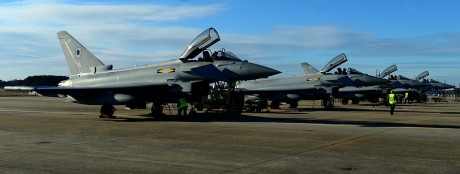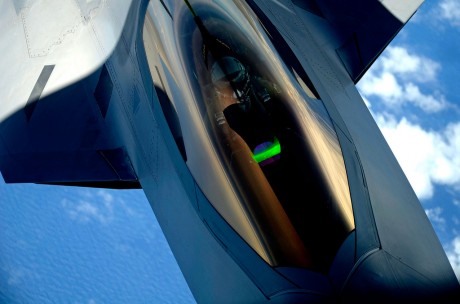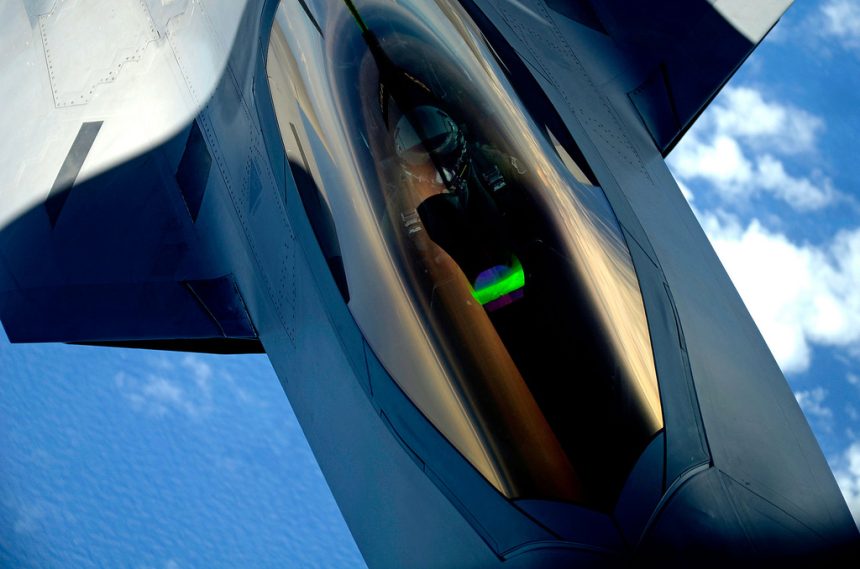Is Thrust Vectoring really important in air-to-air combat? It depends…
A couple of weeks ago, an experienced Eurofighter Typhoon industry test pilot wrote to The Aviationist to respond to a Lockheed F-35 test pilot who, talking to Flight’s Dave Majumdar had claimed that all three variants of the Joint Strike Fighter will have better kinematic performance than any fourth-generation fighter plane with combat payload, including the Eurofighter Typhoon.
Now, the same Typhoon pilot has again chosen this blog (and I’m honored for this) to explain why thrust vectoring, considered one of the most important F-22 features, is not essential when you are involved in an air-to-air engagement WVR (Within Visual Range).
RAF Typhoons and U.S. Air Force F-22s are currently operating together in the U.S.: the joint mission started with a training exercise called Western Zephyr and will continue next week at the Red Flag 13-3 at Nellis Air Force Base.

As reported in an interesting Defensenews article, the agility of the American 5th generation fighter plane is among the things that impressed British pilots the most.
According to the piece, the commander of the RAF XI Sqn Wing Commander Rich Wells, said:
“Raptor has vector thrust: Typhoon doesn’t,” he said. “What the aircraft can do, it’s incredible. The Typhoon just doesn’t do that.”
Even if it is a matter of fact that the European top class fighter jet lacks thrust vectoring (TV) our source believes that this is not a big deal.
To be honest, the points he raises were already discussed in the article about the outcome of the dogfights between the U.S. Air Force F-22 Raptors and the German Air Force Eurofighter Typhoons during last year’s Red Flag – Alaska, when Americans said the F-22 performance was “overwhelming” while German said the costly stealth fighter was “salad” for the Eurofighter’s pilots lunch.
At that time we said that the F-22 tends to lose too much energy when using TV and unless the Raptor can manage to immediately get in the proper position to score a kill, the energy it loses makes it quite vulnerable.
Anyway, here’s what he wrote to us:
We have all been around long enough to recognize there is not a single sensor able to turn the night into day, nor a unique aerodynamic design feature capable of ensuring by itself air dominance if implemented.
The effectiveness of an air superiority fighter relies on the successful combination of a range of design elements including thrust-to-weight ratio, wing loading, avionics and weapons integration. Furthermore, : appropriate tactics and valuable aircrew training must be developed to exploit the full potential of the weapon system.
Typically, when time comes to decide how to achieve the required “nose pointing capability” for high thrust-to-weight ratio airplanes three solutions are on the table:
– extremely high short term sustained Angle of Attack values (characteristic of twin tailed airplanes);
– High Off-Bore-Sight Weapons, preferably supported by Helmet Cueing;
– Thrust Vectoring.
Thrust Vectoring is one of the design elements that can contribute to create a certain advantage during close air combat by generating impressive pitch and yaw rates, but only in a limited portion of the flight envelope at velocities well below “corner speed”.
However, Thrust Vectoring can also transform in a few seconds an energy fighter in a piece of metal literally falling off the sky, making it an easy prey for those who have been able to conserve their energy.
Moreover, Thrust Vector operation requires the pilot to “create the opportunity” for its usage, spending valuable time in manoeuvring the aircraft to achieve a suitable condition and managing the activation of the Thrust Vector Control.
If you are “defensive” and your aircraft has Thrust Vectoring, you can possibly outturn your enemy, but that most likely won’t prove to be a great idea: an energy fighter like the Typhoon will conveniently “use the vertical” to retain energy and aggressively reposition for a missile or gun shot. Also the subsequent acceleration will be extremely time (and fuel) consuming, giving your opponent the opportunity to tail chase you for ever, exploiting all its short range weapon array.
If you are “neutral”, when typically vertical, rolling and flat scissors would accompany the progressive energy decay, similarly performing machines would remain closely entangled, negating the opportunity for Thrust Vector activation.
If you are “offensive”, probably stuck in a never ending “rate fight”, Thrust Vector could provide the opportunity for a couple of shots in close sequence. Make sure nobody is coming to you from the “support structure”, otherwise that could be also your last move.
Talking of twin tailed aircraft, Angles of Attack in excess of 30-35 degrees are capable of creating drag conditions unsustainable no matter the engine/airframe matching, and developing energy decays intrusive of the tactical flying but also of the flight control system protections. Roll rates would also deteriorate at the higher values of AoA and target tracking ability would quickly decay.
Eurofighter has decided to develop for the Typhoon High Off-Bore-Sight Weapons, supported by Helmet Cueing, to retain energy and target tracking ability while manoeuvring WVR (Within Visual Range) at relatively high but sustainable Angles of Attack. For those who may require some additional AoA, the “Strakes” package is progressing well and soon it will be offered to Typhoon’s Customers. Nevertheless, Strakes is not purely about extreme AoA, but also suitable Roll Rates and manageble energy characteristics. Because in the European way of doing things, an all round balanced solution counts more than a single eye opening performance.
It is a fact that against Eastern produced fighters provided with Thrust Vectoring, throughout the years the Typhoon has showed an embarasing (for them) kill-to-loss ratio.
It is a fact that after some initial encounters between the Raptor and the Typhoon, the situation appears of absolute equity. Too early to say if it is the Helmet Cueing or the Thrust Vector, or how much tactics and training are a player in all this. For sure, we are facing two impressively capable machines.
The typical answer to any critics to the F-22 air dominance is: “since it is stealthy, you should not even consider the possibility of a close encounter with another jet.”

Even if this can be true, the risk of coming to close range is still high. At a distance of about 50 km the Typhoon IRST (Infra-Red Search and Track) system could be capable to find even a stealthy plane “especially if it is large and hot, like the F-22″ as a Eurofighter pilot once said.
Furthermore, Raptors are not always stealthy as one might believe: for instance, when they carry external store, rejoin with tankers or talk on the radio (secure or unsecure ones) they become more vulnerable to detection.
But this is another story, that we will discuss in the near future…








